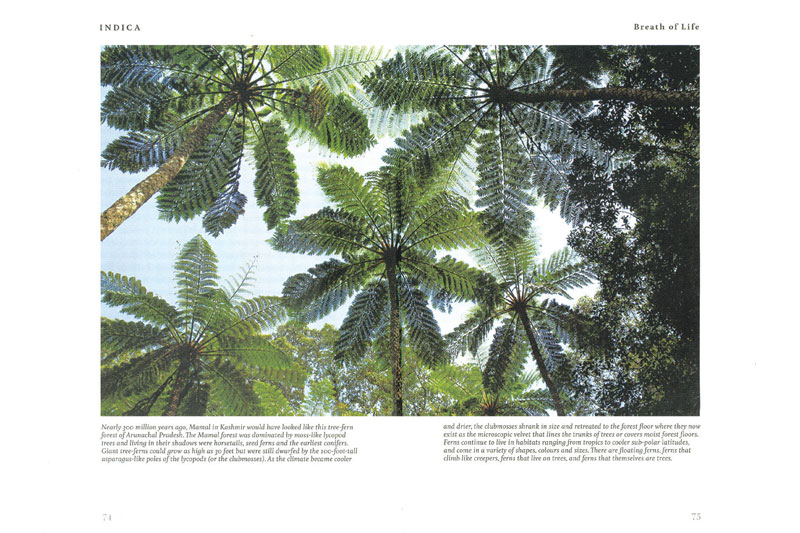Environment
Story of Evolution | Pranay Lal
LA 52 |
|
|
|
|
| INDICA, A Deep Natural History of the Indian Subcontinent by PranayLal, a bio - scientist is a book that captures the attention of a vast section of even the unscientific society. An exemplary, dense work presented in a very created and enagaging manner introduces one to diverse and fascinating knowledge about the history of the earth.
|
|
INDICA, A Deep Natural History of the Indian Subcontinent
Author: Pranay Lal
Published:Penguin Random House Group India Pvt Ltd
|
|
|
What is the chronology of natural history in terms of the formation of India's different regions? Since it was a process that happened millions of years ago, has the present natural character of these places remained same? Broadly, how are they related to the other natural components - soil, water, climate and vegetation?
It is difficult to summarize a 4.5 billion-year story of how landmasses and everything around us came to exist. But here is what I think must have happened - the oldest rocks that laid the foundation of peninsular India formed about 3.6 billion years or so ago. Gradually more large rocks grew around these, and over above these over millions of years several other layers of rocks got arranged. The early years when the Earth was still a molten metal ball, an assault of meteors and asteroids contributed to elements, and more importantly these meteors contained within them tiny crystals of ice. As they entered Earth's atmosphere and hit the ground, the heat from the collision liberated this ice, converting it into water vapour. Often when meteorites penetrated the crust of the Earth, they released molten iron on to the surface, which catalyzedcarbon monoxide to combine with hydrogen to create water vapour. A molten core of the Earth gave rise to tectonic forces, which caused the landmasses to move, creating bowl-shaped basins which were gradually filled with water. These formed the first oceans. The action of heat, water, and later rain broke down rocks to create the earliest soils. The earliest lifeforms were hardy single-celled organisms that emerged around 3.5 billion years or so. A series of fortuitous events led to the creation of new lifeforms that we see around us today. Lifeforms influence soils and climate, while climate and soils determine how many and which species would live off them. The whole drama of one having a subliminal effect on the other is fascinating!
The region roughly between Bangalore and Dharwar is the oldest, and is about 3.5 billion years old. New pieces were added around it, first the Singhbhum to the east, then-the Bundelkhandcraton by 2.5 million years ago. This was the time when the Aravallis began to rise - this makes them the world's oldest fold mountains.East of the Aravallis the Vindhyas and Satpuraswere forming. The Eastern Ghats were part of the contiguous spine of mountains which formed the margin with Antarctica and Australia. Between 170 and 167 million years ago, the supercontinent (Gondwana) broke up into two parts forming East Gondwana (made up of Antarctica, Australia, New Zealand, Madagascar, Seychelles, India and Sri Lanka) and West Gondwana (consisting of Africa, Arabia and South America). An ocean began to open up between these two landmasses, which later became the Indian Ocean. With each landmass now separated from one another, India along with Madagascar and Sri Lanka in tow began their journey northwards. Madagascar had torn away from Africa 128 million years ago, but remained attached to Greater India for another 40 million years. When Madagascar finally went its separate way, it travelled west and rested east of Mozambique, separated from East Africa by a narrow channel of wate. It took Greater India 110 million years to traverse 9000 kilometres before it barged into the Eurasian Plate 50 million years ago, thus creating the Himalaya and Tibet, and the mighty rivers and the great plains.
When one realizes that the time scale for change in nature is in millions of years, then how does one adopt a tangible understanding of it while comprehending ecosystems and landscapes?
To answer this we need to keep in mind the fundamental reasons why life exists on Earth and perhaps nowhere else. First, Earth has a molten core which influences activity in the mantle and re-arranges the plates which are part ofthe crust. Second, Earth, though, is at the perfect distance from the Sun to avoid getting incinerated. Its gravity is just enough to keep its atmosphere from dissipating into outer space, and its favourable atmospheric pressure is just right to prevent life forms from being crushed. Third, a dynamic Earth led to the evolution of elements and compounds which influenced, and in turn also influenced the creation of new compounds. The Earth's atmosphere was once full of poisonous gases or composed of elements that are incapable of supporting life, but several processes enabled conditions for the creation of sustainable life. All these needed to occur in the right order for life to become possible. Landscapes and ecosystems have evolved under complex relationships with rocks, soils, water and lifeforms. Each lifeform and landscape around us has taken millions of years and we have only just begun understanding a few of these processes. Let me cite an example: Until the mid- 1990s, the world's largest source of oxygen was thought to be trees, but the discovery of an ocean-dwelling phytoplankton (Prochlorococcusalong with its cousin Synechococcus) in 1988 confirmed that these particular organisms were the most abundant photosynthetic cells on Earth and produce more oxygen than all forests combined. We have made strong assumptions upon which we have based our development models. Using bad science to inform policy is fraught with danger and taking the planet to the brink of calamity.
|
|


|
|

| |
|
|
|